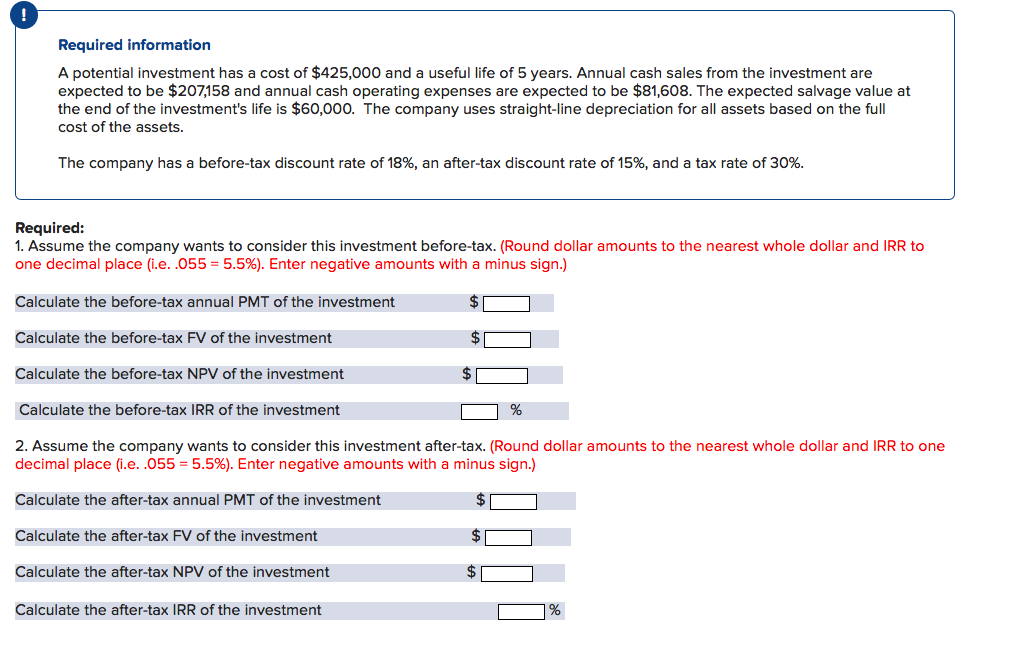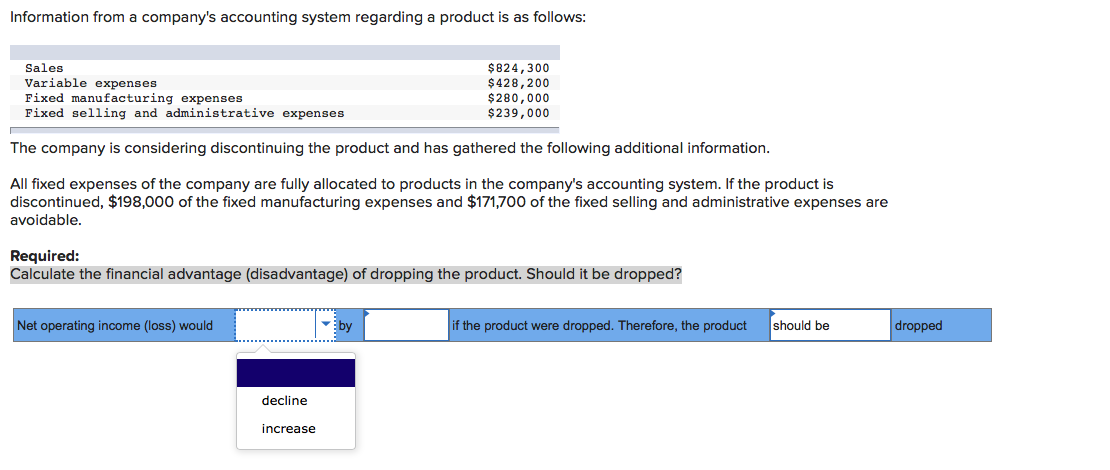Required information A potential investment has a cost of $425,000 and a useful life of 5 years. Annual cash sales from the investment are expected to be $207,158 and annual cash operating expenses are expected to be $81,608. The expected salvage value at the end of the investment's life is $60,000. The company uses straight-line depreciation for all assets based on the full cost of the assets. The company has a before-tax discount rate of 18%, an after-tax discount rate of 15%, and a tax rate of 30%. ired:
Required information A potential investment has a cost of $425,000 and a useful life of 5 years. Annual cash sales from the investment are expected to be $207,158 and annual cash operating expenses are expected to be $81,608. The expected salvage value at the end of the investment's life is $60,000. The company uses straight-line depreciation for all assets based on the full cost of the assets. The company has a before-tax discount rate of 18%, an after-tax discount rate of 15%, and a tax rate of 30%. ired:
Chapter11: Long-term Assets
Section: Chapter Questions
Problem 13PA: Colquhoun International purchases a warehouse for $300,000. The best estimate of the salvage value...
Related questions
Question
N4.
Account

Transcribed Image Text:!
Required information
A potential investment has a cost of $425,000 and a useful life of 5 years. Annual cash sales from the investment are
expected to be $207,158 and annual cash operating expenses are expected to be $81,608. The expected salvage value at
the end of the investment's life is $60,000. The company uses straight-line depreciation for all assets based on the full
cost of the assets.
The company has a before-tax discount rate of 18%, an after-tax discount rate of 15%, and a tax rate of 30%.
Required:
1. Assume the company wants to consider this investment before-tax. (Round dollar amounts to the nearest whole dollar and IRR to
one decimal place (i.e. .055 = 5.5%). Enter negative amounts with a minus sign.)
Calculate the before-tax annual PMT of the investment
Calculate the before-tax FV of the investment
Calculate the before-tax NPV of the investment
Calculate the after-tax NPV of the investment
$
Calculate the before-tax IRR of the investment
2. Assume the company wants to consider this investment after-tax. (Round dollar amounts to the nearest whole dollar and IRR to one
decimal place (i.e. .055 = 5.5%). Enter negative amounts with a minus sign.)
Calculate the after-tax annual PMT of the investment
Calculate the after-tax FV of the investment
Calculate the after-tax IRR of the investment
%
%

Transcribed Image Text:Information from a company's accounting system regarding a product is as follows:
Sales
Variable expenses.
Fixed manufacturing expenses.
Fixed selling and administrative expenses
The company is considering discontinuing the product and has gathered the following additional information.
All fixed expenses of the company are fully allocated to products in the company's accounting system. If the product is
discontinued, $198,000 of the fixed manufacturing expenses and $171,700 of the fixed selling and administrative expenses are
avoidable.
Required:
Calculate the financial advantage (disadvantage) of dropping the product. Should it be dropped?
Net operating income (loss) would
decline
$824,300
$428,200
$280,000
$239,000
increase
by
if the product were dropped. Therefore, the product
should be
dropped
Expert Solution
This question has been solved!
Explore an expertly crafted, step-by-step solution for a thorough understanding of key concepts.
This is a popular solution!
Trending now
This is a popular solution!
Step by step
Solved in 5 steps with 8 images

Recommended textbooks for you

Principles of Accounting Volume 1
Accounting
ISBN:
9781947172685
Author:
OpenStax
Publisher:
OpenStax College

Managerial Accounting
Accounting
ISBN:
9781337912020
Author:
Carl Warren, Ph.d. Cma William B. Tayler
Publisher:
South-Western College Pub

Intermediate Financial Management (MindTap Course…
Finance
ISBN:
9781337395083
Author:
Eugene F. Brigham, Phillip R. Daves
Publisher:
Cengage Learning

Principles of Accounting Volume 1
Accounting
ISBN:
9781947172685
Author:
OpenStax
Publisher:
OpenStax College

Managerial Accounting
Accounting
ISBN:
9781337912020
Author:
Carl Warren, Ph.d. Cma William B. Tayler
Publisher:
South-Western College Pub

Intermediate Financial Management (MindTap Course…
Finance
ISBN:
9781337395083
Author:
Eugene F. Brigham, Phillip R. Daves
Publisher:
Cengage Learning

Excel Applications for Accounting Principles
Accounting
ISBN:
9781111581565
Author:
Gaylord N. Smith
Publisher:
Cengage Learning

EBK CONTEMPORARY FINANCIAL MANAGEMENT
Finance
ISBN:
9781337514835
Author:
MOYER
Publisher:
CENGAGE LEARNING - CONSIGNMENT

College Accounting, Chapters 1-27
Accounting
ISBN:
9781337794756
Author:
HEINTZ, James A.
Publisher:
Cengage Learning,